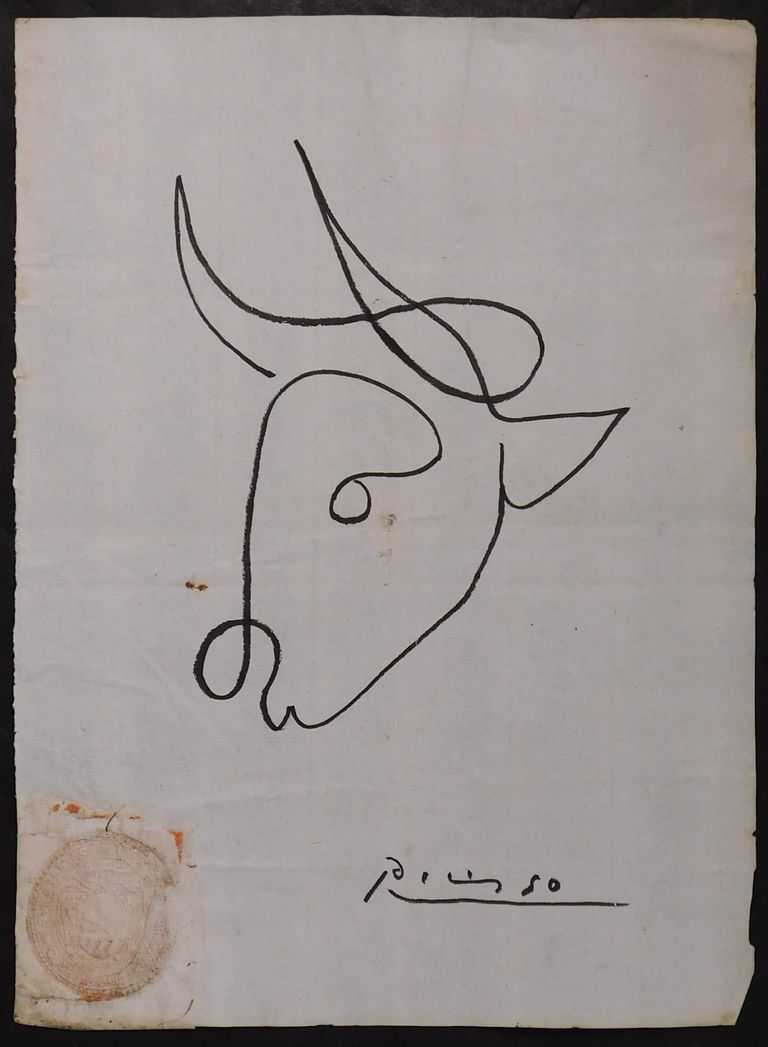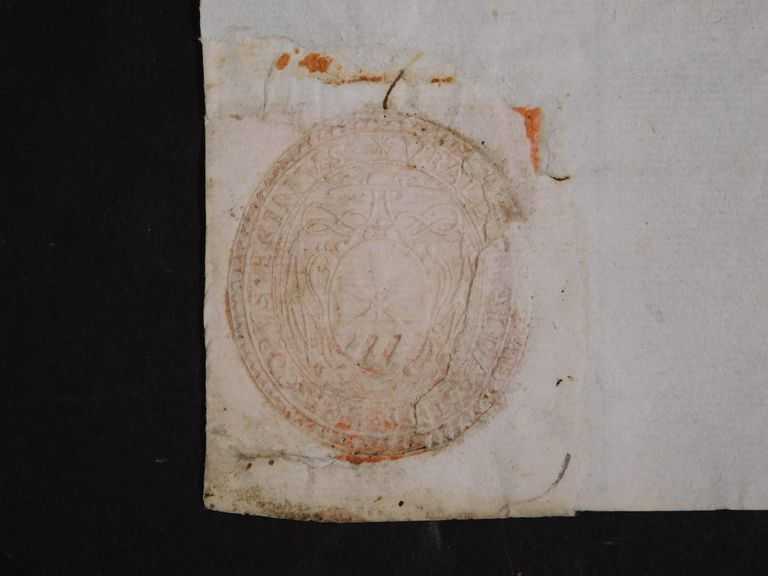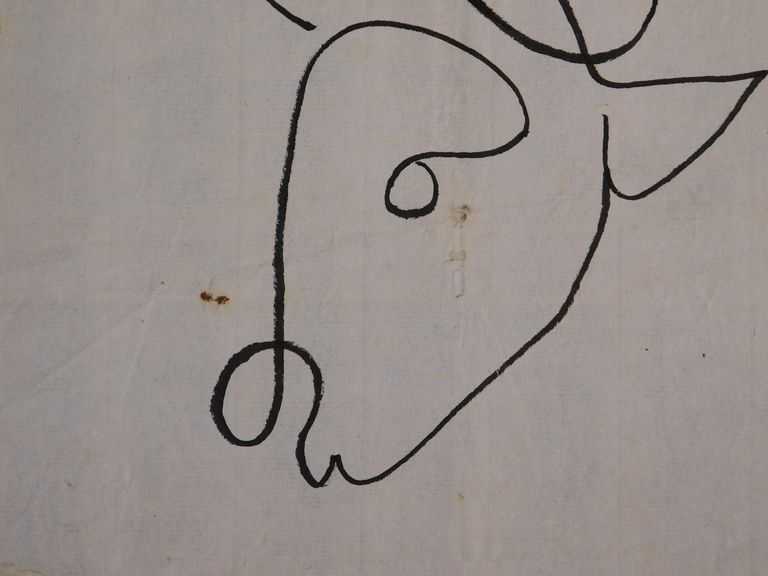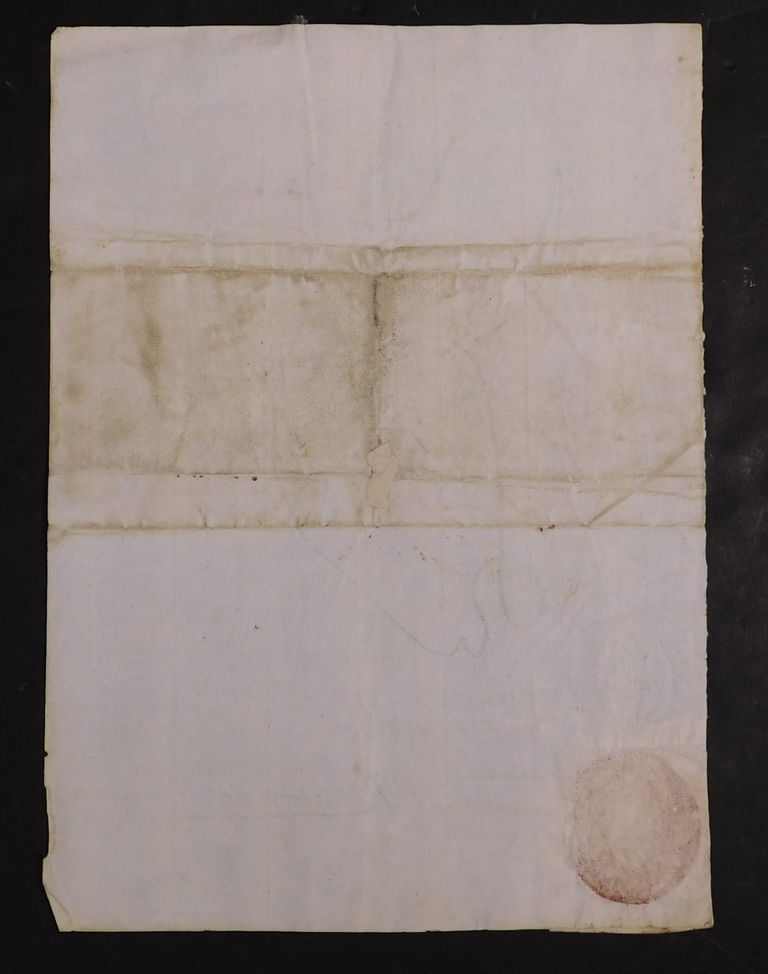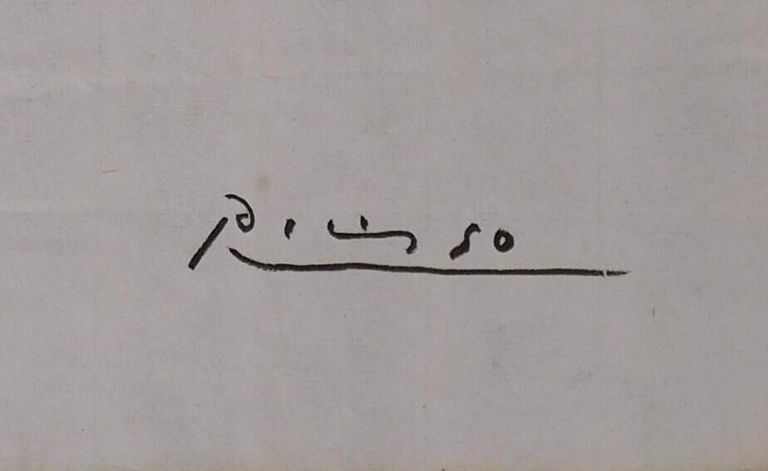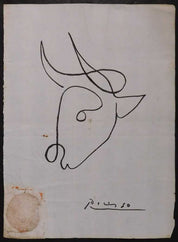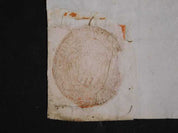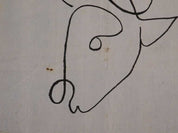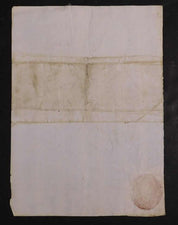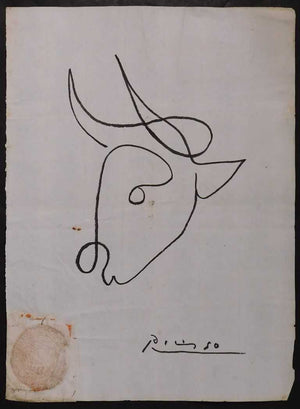Similar Items
Pablo Picasso (Manner of) 'The Bull'
$2,500.00 USD
Manner of Pablo Picasso: "Bull"
In this line drawing, we see a head of a bull rendered in the distinctive style associated with the renowned artist Pablo Picasso. Bulls, one of the recurring motifs in his body of work, have inspired numerous interpretations in Picasso's art.
Details:
Artist: Pablo Picasso (Spanish, 1881-1973) - Manner of
Title: Bull
Medium: Ink on Laid Paper
Dimensions: 11 x 8 in (27.9 x 20.3 cm)
Condition Report:
The artwork is in fair condition, but it exhibits signs of aging and handling throughout. The right and left edges of the paper appear ragged, likely due to wear over time. Additionally, a dent and a stain are visible in the center of the paper, and there are creases from previous folding.
Notes:
Picasso's signature is found in the lower right corner, a testament to the connection between this work and the renowned artist's oeuvre. Moreover, a collector's stamp is affixed to the lower left corner of the paper, adding to the artwork's provenance and historical context.
About the Artist:
Pablo Picasso, born in Málaga, Spain, on October 25, 1881, and passed away in Mougins, France, on April 8, 1973, was an exceptional Spanish-born French artist celebrated for his contributions to painting, sculpture, printmaking, ceramics, and stage design. His father, a drawing professor, played a role in training young Picasso, whose early works were exhibited when he was only 13 years old. Picasso's artistic journey led him to Paris in 1904, where he transitioned from his Blue Period (1901-1904), characterized by predominantly blue tones, to his Rose Period (1904-1906), which featured pottery and flesh hues.
Among his numerous works, "Les Demoiselles d'Avignon" (1907) stands out as one of Picasso's first masterpieces, known for its striking and controversial treatment of the female body and its incorporation of African art influences. Picasso's collaboration with Georges Braque from 1909 to 1912 gave rise to Cubism, an innovative artistic movement breaking away from traditional Renaissance practices, particularly in the realms of perspective and illusion. Picasso and Braque's Cubism presented a new reality that embraced multiple perspectives, axes, and light sources within a single image. The artists even experimented with gluing paper and other materials onto their canvases during this period.
Throughout his life, Picasso explored diverse subject matters, including Surrealist themes in the 1920s and 1930s, symbolized by his fascination with the Minotaur. In response to the Spanish Civil War, he created "Guernica" (1937), a powerful condemnation of senseless destruction. In later years, Picasso joined the Communist Party and delved into sculpture, ceramics, lithography, and painting, often reinterpreting the works of earlier artists. His famous series of 58 pictures based on Diego Velázquez's "Las Meninas" exemplifies his talent and influence on modern art throughout the 20th century.
As one of the most significant figures in the art world, Picasso's artistic production spanned nearly 80 years, making invaluable contributions to the development of modern art and securing his enduring legacy as a visionary and trailblazing artist.
In this line drawing, we see a head of a bull rendered in the distinctive style associated with the renowned artist Pablo Picasso. Bulls, one of the recurring motifs in his body of work, have inspired numerous interpretations in Picasso's art.
Details:
Artist: Pablo Picasso (Spanish, 1881-1973) - Manner of
Title: Bull
Medium: Ink on Laid Paper
Dimensions: 11 x 8 in (27.9 x 20.3 cm)
Condition Report:
The artwork is in fair condition, but it exhibits signs of aging and handling throughout. The right and left edges of the paper appear ragged, likely due to wear over time. Additionally, a dent and a stain are visible in the center of the paper, and there are creases from previous folding.
Notes:
Picasso's signature is found in the lower right corner, a testament to the connection between this work and the renowned artist's oeuvre. Moreover, a collector's stamp is affixed to the lower left corner of the paper, adding to the artwork's provenance and historical context.
About the Artist:
Pablo Picasso, born in Málaga, Spain, on October 25, 1881, and passed away in Mougins, France, on April 8, 1973, was an exceptional Spanish-born French artist celebrated for his contributions to painting, sculpture, printmaking, ceramics, and stage design. His father, a drawing professor, played a role in training young Picasso, whose early works were exhibited when he was only 13 years old. Picasso's artistic journey led him to Paris in 1904, where he transitioned from his Blue Period (1901-1904), characterized by predominantly blue tones, to his Rose Period (1904-1906), which featured pottery and flesh hues.
Among his numerous works, "Les Demoiselles d'Avignon" (1907) stands out as one of Picasso's first masterpieces, known for its striking and controversial treatment of the female body and its incorporation of African art influences. Picasso's collaboration with Georges Braque from 1909 to 1912 gave rise to Cubism, an innovative artistic movement breaking away from traditional Renaissance practices, particularly in the realms of perspective and illusion. Picasso and Braque's Cubism presented a new reality that embraced multiple perspectives, axes, and light sources within a single image. The artists even experimented with gluing paper and other materials onto their canvases during this period.
Throughout his life, Picasso explored diverse subject matters, including Surrealist themes in the 1920s and 1930s, symbolized by his fascination with the Minotaur. In response to the Spanish Civil War, he created "Guernica" (1937), a powerful condemnation of senseless destruction. In later years, Picasso joined the Communist Party and delved into sculpture, ceramics, lithography, and painting, often reinterpreting the works of earlier artists. His famous series of 58 pictures based on Diego Velázquez's "Las Meninas" exemplifies his talent and influence on modern art throughout the 20th century.
As one of the most significant figures in the art world, Picasso's artistic production spanned nearly 80 years, making invaluable contributions to the development of modern art and securing his enduring legacy as a visionary and trailblazing artist.
Popular Items
































